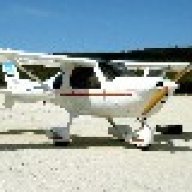Have had both issues with static and pitot blockages in the past. For future ref for others: Low airspeed indication (stopped or erratic) indicated pitot system. Cleared some muck out of the static line and everything was normal again.
If trying to clear a suspected blockage, NEVER blow into the pitot tube with the ASI connected (Chances are you will ruin your ASI)... a very gentle huff in the vicinity of the pitot will show ASI movement if it is working.
In my case, a STATIC blockage caused erratic behaviour of ASI and VSI (jumping erratically together as J430 described) also, ASI indicated higher airspeed than actual, red lining at cruise setting in the circuit (I don't think so) ....good time to forget the ASI and fly by feel (Subsequently noted IAS of 80kts as stall warning sounded on touchdown). Cleared the static line and all worked perfectly again.


